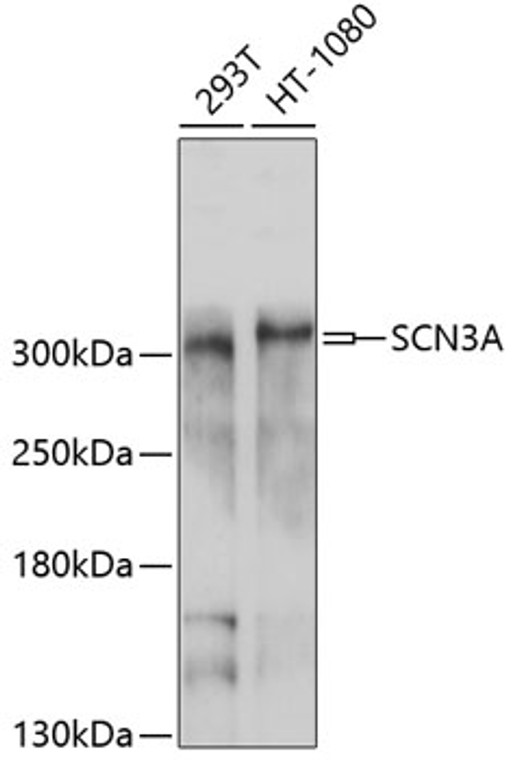| Host: |
Rabbit |
| Applications: |
WB/ELISA |
| Reactivity: |
Human |
| Note: |
STRICTLY FOR FURTHER SCIENTIFIC RESEARCH USE ONLY (RUO). MUST NOT TO BE USED IN DIAGNOSTIC OR THERAPEUTIC APPLICATIONS. |
| Clonality: |
Polyclonal |
| Conjugation: |
Unconjugated |
| Isotype: |
IgG |
| Formulation: |
PBS with 0.02% Sodium Azide, 50% Glycerol, pH 7.3. |
| Purification: |
Affinity purification |
| Concentration: |
Lot specific |
| Dilution Range: |
WB:1:500-1:1000ELISA:Recommended starting concentration is 1 Mu g/mL. Please optimize the concentration based on your specific assay requirements. |
| Storage Instruction: |
Store at-20°C for up to 1 year from the date of receipt, and avoid repeat freeze-thaw cycles. |
| Gene Symbol: |
SCN3A |
| Gene ID: |
6328 |
| Uniprot ID: |
SCN3A_HUMAN |
| Immunogen Region: |
274-400 |
| Specificity: |
Recombinant fusion protein containing a sequence corresponding to amino acids 274-400 of human SCN3A (NP_008853.3). |
| Immunogen Sequence: |
RNKCLQWPPSDSAFETNTTS YFNGTMDSNGTFVNVTMSTF NWKDYIGDDSHFYVLDGQKD PLLCGNGSDAGQCPEGYICV KAGRNPNYGYTSFDTFSWAF LSLFRLMTQDYWENLYQLTL RAAGKTY |
| Tissue Specificity | Expressed in enterochromaffin cells in both colon and small bowel (at protein level). |
| Post Translational Modifications | May be ubiquitinated by NEDD4L.which would promote its endocytosis. Phosphorylation at Ser-1501 by PKC in a highly conserved cytoplasmic loop slows inactivation of the sodium channel and reduces peak sodium currents. |
| Function | Pore-forming subunit of Nav1.3, a voltage-gated sodium (Nav) channel that directly mediates the depolarizing phase of action potentials in excitable membranes. Navs, also called VGSCs (voltage-gated sodium channels) or VDSCs (voltage-dependent sodium channels), operate by switching between closed and open conformations depending on the voltage difference across the membrane. In the open conformation they allow Na(+) ions to selectively pass through the pore, along their electrochemical gradient. The influx of Na+ ions provokes membrane depolarization, initiating the propagation of electrical signals throughout cells and tissues. In some secretory cell types, it also participates in cell excitability through membrane depolarization and regulates cells responsiveness to stimuli triggering secretion. For instance, it controls the release of serotonin/5-hydroxytryptamine by enterochromaffin cells and is required for both glucagon- and glucose-induced insulin secretion in pancreatic endocrine cells. |
| Protein Name | Sodium Channel Protein Type 3 Subunit AlphaSodium Channel Protein Brain Iii Subunit AlphaSodium Channel Protein Type Iii Subunit AlphaVoltage-Gated Sodium Channel Subtype IiiVoltage-Gated Sodium Channel Subunit Alpha Nav1.3 |
| Database Links | Reactome: R-HSA-445095Reactome: R-HSA-5576892Reactome: R-HSA-9717207 |
| Cellular Localisation | Cell MembraneMulti-Pass Membrane ProteinBasal Cell MembraneIn Enterochromaffin CellsLocalized Highly AsymmetricallyAlmost Exclusively At The Basal Side |
| Alternative Antibody Names | Anti-Sodium Channel Protein Type 3 Subunit Alpha antibodyAnti-Sodium Channel Protein Brain Iii Subunit Alpha antibodyAnti-Sodium Channel Protein Type Iii Subunit Alpha antibodyAnti-Voltage-Gated Sodium Channel Subtype Iii antibodyAnti-Voltage-Gated Sodium Channel Subunit Alpha Nav1.3 antibodyAnti-SCN3A antibodyAnti-KIAA1356 antibodyAnti-NAC3 antibody |
Information sourced from Uniprot.org
12 months for antibodies. 6 months for ELISA Kits. Please see website T&Cs for further guidance







